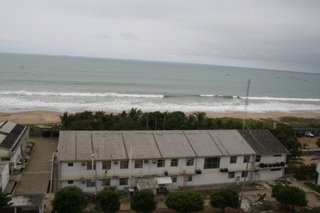
Bienvenidos Camarones!!
Hi. I am now in Guayaquil and as predicted I am in the heat for the first time during my journey. I was collected from the aiport by Claudia Mussello (an ex-student of Karin Lohrmann of UCN in Chile) and dropped at my hotel in downtown Guayaquil. Many of the hotels are in an area known as the Malecon, a regeneration project that was completed on the millenium. The Malecon region which flanks the Guayas river that flows through the city was a notoriously violent and dangerous slum prior to the project but now is one of the nicest areas of the city, with tropical gardens, shops, cafe bars and art galeries. It is a safe place to take a stroll in the summer heat, albeit under the watchful eye of the many armed security guards that man the gates and frequent the boulevard.
The streets of Guayaquil itself are not a safe environment for the tourist at night but by day are colourful, cultural and vibrant. My first meeting of the week was with father and son team Colin and Nick Armstrong, who run Agripac S.A. Agripac provide agrochemicals, feeds and formulations to the Ecuadorian agricultural and aquacultural sector and have a significant interest in the national prawn industry. As Consul to the British Embassy in Quito, Colin with his significant understanding of Ecuadorian culture (35 yrs in country) provided me with plenty of contacts in the industry. I also thank him for introducing me to the Pheonix Club on the 6th floor of a Guayaquil city tower. The club, mainly for British ex-pats was a somewhat sureal experience (think British pub in the middle of a tropical city!). Several games of darts, a couple of beers (served in British pint tankards) and some garlic prawns (produced locally) finsihed a very nice evening (i met another 3 ex-Nottingham graduates in the club that night!).
Next morning I was met at the hotel by Dr Sam Stern, director of CENAIM (National Aquaculture and Marine Research Centre) and Dr Daniel Gutierrez, a sociologist from ESPOL (Escuela Superior Politecnica del Littoral) for a trip to the CENAIM marine outstation in San Pedro de Manglaralto on the Pacific coast of Ecuador (picture above). Sam described the mission of CENAIM as a research organisation that is attempting to link the requirements of the aquaculture industry with the skills provided by academic institutes in country. On arrival at the centre, around 2 hours west of Guayaquil, we were greeted by Dr Stanislaus Sonnenholzner, somebody who has provided me with significant assistance in putting together my itinerary for this trip (many thanks to him). The lab is in a great location, fronted by one of the best surf beaches in Ecuador.
Stan gave me a full tour of the CENAIM station and described the attempts by CENAIM to promote diversification in the Ecuadorian aquaculture industry (which to date has and is focussed almost solely on production of tropical prawns for the US and European markets). Specifically, as already seen in Chile, there are pilot projects to close the life cycle for a range of fish and mollusc species, including 'Guiyaipi' (large tunny-like fish), Japanese oyster, native scallop and Spondylus spp. The latter is not only being grown as a potential food source but also as a means of producing pearls for the jewellery industry. By grafting small foreign bodies to the inside of the shell of live Spondylus, it is possible to induce a host immune reaction that surronds the graft and produces a half pearl (see the pic below). In addition, injection of cell lines and/or tissue grafts into the mantle of this species can lead to the production of full pearls.
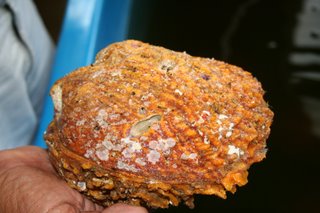
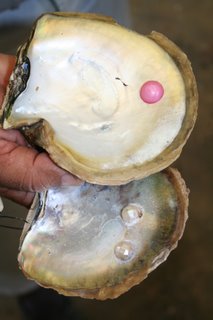
Spondylus spp. are being used to grow artificial pearls using foreign bodies (pink) grafted to the inner shell of live animals.
A stop off at CENAIM's prawn research facility just outside of San Pedro gave me an opportunity to see the type of prawn farm responsible for producing the tropical prawns found in supermarkets in the UK, Europe and the US. Seawater is pumped into the ponds and prawn larvae are grown to market size within about 12o days (2-3 harvests being possible each year). One of the major reasons for the trip to Ecuador was to talk to researchers and industry about the problems experienced in production of prawns in the region, particularly in relation to the diseases which have plagued the industry over several years. Ecuador experienced a catastrophic epidemic of white spot syndrome virus (WSSV) during the late 1990' and is only now recovering to around full capacity. Other viral diseases such as Taura Syndrome Virus (TSV) and Yellow Head Virus (YHV) are also of significant threat to the global industry. Rapid, unchecked expansion of the industry and poor biosecurity responsible for epidemics...this being more carefully considered in modern operations. The species being farmed are white Pacific prawn (Penaeus vannemei)....look out for this name on the shrimp bags in Tesco's!!
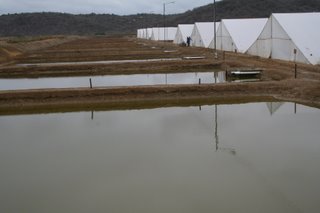
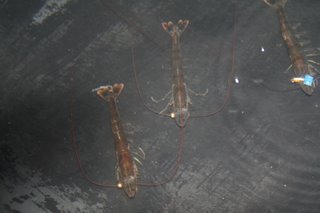
CENAIM's experimental shrimp farming facility at San Pedro (left) and Penaeus vannamei broodstock at the lab. Shrimp are individually labelled (most visible on the one at right of picture) for genetic selection during the breeding process. Collection of broodstock from the wild has been outlawed in Ecuador in order to protect native stocks and to prevent introduction of diseases such as viruses from wild animals.
And finally, just for John, take a look at this giant mussel species being cultured at CENAIM. I did not catch the name but it looked like a bike seat and apparently this is only half full size. The adductor muscle is the target for food...apparently the size of a small fillet steak!!
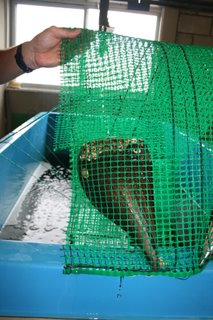

2 Comments:
Hi Grant.... sorry to hear about the standard of clientele in your hotel... well I suppose life can be hard... you just have to get you head down and take it on the chin ;)
Thanks for your support Dr Lyons. I knew you would understand!
Post a Comment
<< Home